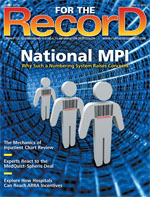 June 21, 2010
June 21, 2010
Coding for Sleep Apnea
For The Record
Vol. 22 No. 12 P. 28
Sleep apnea is a disorder that causes a person to repeatedly stop and start breathing while sleeping; the interrupted breathing creates a lack of oxygen in the brain. Breathing cessation may occur hundreds of times during the night and last for one minute or longer.
Types of Sleep Apnea
The following are the common types of sleep apnea:
• Obstructive sleep apnea (ICD-9-CM code 327.23) is most common and is caused by an airway blockage that occurs when the soft tissue in the back of the throat narrows or closes during sleep. The brain then senses the inability to breathe and briefly arouses the person to begin breathing again.
• Central sleep apnea (327.27) occurs when the brain doesn’t send proper signals to the muscles that control breathing, and the person may awaken with shortness of breath. Code first for the underlying condition.
• Complex or mixed sleep apnea is a combination of both obstructive and central sleep apnea.
Other related ICD-9-CM codes are as follows:
• Primary central sleep apnea (327.21);
• High-altitude periodic breathing (327.22);
• Idiopathic sleep-related nonobstructive alveolar hypoventilation (327.24), which may also be documented as sleep-related hypoxia;
• Congenital central alveolar hypoventilation syndrome (327.25);
• Sleep-related hypoventilation/hypoxemia in conditions classifiable elsewhere (327.26), where the underlying condition should be coded first;
• Organic sleep apnea, unspecified (327.20);
• Other organic sleep apnea (327.29);
• Insomnia with sleep apnea (780.51), which includes hyposomnia with sleep apnea;
• Hypersomnia with sleep apnea (780.53); and
• Unspecified sleep apnea (780.57).
Symptoms and Complications
Signs and symptoms for both obstructive and central sleep apnea include hypersomnia (daytime sleepiness), loud snoring (more prominent in obstructive sleep apnea), intermittent pauses in breathing, abrupt awakenings accompanied by shortness of breath (may indicate central sleep apnea), awakening with a dry mouth or sore throat, a morning headache, and insomnia.
If untreated, sleep apnea may cause conditions such as cardiovascular disease, stroke, memory problems, weight gain, impotence, headaches, diabetes, depression or mood swings, attention-deficit/hyperactivity disorder, and gastroesophageal reflux disease.
Treatment
Treatment for obstructive sleep apnea may include the following:
• Continuous positive airway pressure (CPAP) (93.90), which keeps the upper-airway passages open and prevents apnea and snoring.
• Bilevel positive airway pressure (BiPAP) (93.90), which provides more pressure during inhalation and less when exhaled.
• An oral appliance, which may open the throat by bringing the jaw forward. It may be easier to use than CPAP but not as effective.
• Uvulo-palato-pharyngoplasty (27.69 + 29.4), which removes tissue from the back of the mouth and top of throat. Code also any insertion of a palatal implant (27.64).
• Maxillomandibular advancement, which moves the upper and lower part of the jaw forward and enlarges the space behind the tongue and soft palate.
• Tracheostomy (31.29), which is only performed in severe, life-threatening cases. The patient will use the opening only at night and close it during the day.
• Removal of nasal polyps (21.31).
• Repair of deviated nasal septum.
• Removal of tonsils and adenoids.
Coding and sequencing for sleep apnea are dependent on the physician documentation in the medical record and application of the Official Coding Guidelines for inpatient care. Also, use specific AHA Coding Clinic for ICD-9-CM and American Medical Association CPT Assistant references to ensure complete and accurate coding.
— This information was prepared by Audrey Howard, RHIA, of 3M Consulting Services. 3M Consulting Services is a business of 3M Health Information Systems, a supplier of coding and classification systems to more than 5,000 healthcare providers. The company and its representatives do not assume any responsibility for reimbursement decisions or claims denials made by providers or payers as the result of the misuse of this coding information. More information about 3M Health Information Systems is available at www.3mhis.com or by calling 800-367-2447.



